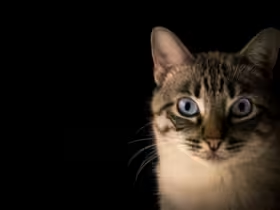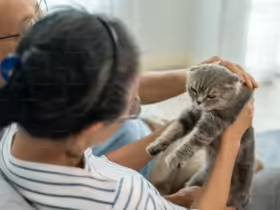Cataracts are a common eye condition in both humans and animals, including cats. If you’ve noticed any changes in your cat’s vision or appearance of its eyes, it could be a sign of cataracts. This comprehensive guide will provide you with essential information about cat cataracts, including symptoms, causes, diagnosis, treatment options, and prevention strategies.
What Are Cataracts?
Cataracts are a condition where the lens of the eye becomes cloudy or opaque, affecting vision. In a healthy eye, the lens is clear and allows light to pass through to the retina. When a cataract forms, it disrupts this process, leading to impaired vision.
Symptoms of Cataracts in Cats
Recognizing cataracts in cats can be challenging, especially since cats are adept at hiding discomfort. However, some signs to watch for include:
- Cloudy or Opaque Eyes: One or both of your cat’s eyes may appear milky or bluish, a classic sign of cataracts.
- Vision Changes: Difficulty navigating, bumping into objects, or hesitation in familiar environments can indicate vision issues.
- Increased Tearing: An increase in tear production or discharge from the eyes may occur.
- Eye Redness or Irritation: The eye may appear red or inflamed, though this can also be a sign of other conditions.
- Behavioral Changes: Affected cats might display changes in behavior such as increased vocalization, aggression, or lethargy.
Causes of Cataracts in Cats
Cataracts in cats can be caused by various factors, including:
- Genetics: Some cat breeds are more prone to developing cataracts due to inherited genetic factors. Breeds like the Siamese, Persian, and Maine Coon are known to have a higher incidence of cataracts.
- Diabetes Mellitus: Diabetic cats are at a higher risk of developing cataracts. Elevated blood sugar levels can affect the lens of the eye, leading to cataract formation.
- Age-Related Changes: Just as in humans, older cats can develop cataracts as part of the natural aging process.
- Trauma: Injury to the eye or head can cause cataracts to develop as a complication.
- Uveitis: Inflammation of the uveal tract (the middle layer of the eye) can lead to cataracts.
- Toxicity: Exposure to certain toxins or medications can contribute to cataract development.
Diagnosing Cataracts in Cats
If you suspect your cat has cataracts, a visit to the veterinarian is essential for an accurate diagnosis. Your vet will likely perform the following:
- Eye Examination: A thorough examination of your cat’s eyes using specialized instruments.
- Ophthalmoscopy: An examination of the retina and lens using a device called an ophthalmoscope.
- Ultrasound: In some cases, an ultrasound of the eye may be necessary to assess the extent of the cataract and other underlying issues.
- Blood Tests: To check for underlying conditions like diabetes or other health issues that might be contributing to the cataracts.
Treatment Options for Cataracts in Cats
Treatment for cataracts depends on the severity of the condition and the underlying cause. Options include:
- Medical Management:
- Managing Underlying Conditions: For cats with diabetes, controlling blood sugar levels can help slow the progression of cataracts.
- Anti-Inflammatory Medications: If cataracts are due to inflammation, your vet may prescribe anti-inflammatory medications.
- Surgical Treatment:
- Cataract Surgery: The most effective treatment for cataracts is surgical removal of the cloudy lens and replacement with an artificial lens. This procedure is performed by a veterinary ophthalmologist and is generally successful in restoring vision.
- Supportive Care:
- Environmental Modifications: Make adjustments to your cat’s environment to help them navigate more easily. Providing a safe, clutter-free space can help reduce the risk of accidents.
- Nutritional Support: A balanced diet rich in antioxidants may support overall eye health.
Post-Surgery Care
If your cat undergoes cataract surgery, follow your vet’s instructions for post-operative care, which may include:
- Medication Administration: Administer prescribed eye drops or medications as directed.
- Follow-Up Visits: Regular check-ups with your vet to monitor healing and ensure the success of the surgery.
- Restricting Activity: Limit your cat’s activity to prevent any strain or injury to the healing eye.
Preventing Cataracts in Cats
While not all cataracts can be prevented, you can take steps to reduce your cat’s risk:
- Regular Veterinary Check-Ups: Routine eye exams can help catch early signs of cataracts or other eye conditions.
- Diabetes Management: If your cat is diabetic, maintaining proper blood sugar levels is crucial.
- Protect Against Injury: Keep your cat safe from potential eye injuries and trauma.
- Balanced Diet: Provide a diet rich in essential nutrients and antioxidants to support overall health, including eye health.











Leave a Reply